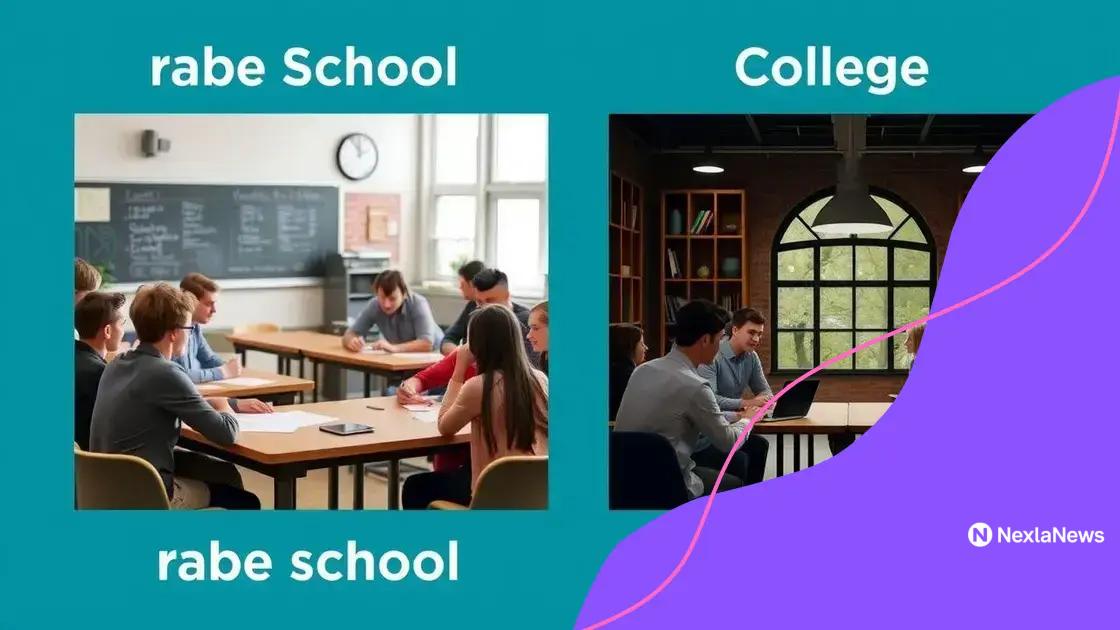Trade school vs college: which path is right for you?

Trade schools provide specialized training for specific careers, allowing students to enter the workforce quickly, while traditional colleges offer a broader education but typically involve higher costs and longer programs.
Trade school vs college poses a significant decision for many students today. As education evolves, knowing which path fits your career goals can shape your future. Let’s dive into the unique advantages each option offers.
Understanding trade schools
Understanding trade schools is crucial for students reconsidering their education options. These institutions focus on providing specialized skills for specific careers, equipping students to enter the workforce quickly.
Unlike traditional colleges that offer broader academic education, trade schools center on hands-on experiences and practical training. Students can often complete programs in as little as a year or two.
Key Features of Trade Schools
Many students choose trade schools for the following reasons:
- Shorter duration of programs compared to traditional colleges
- Greater focus on practical skills applicable to specific jobs
- Usually lower tuition costs leading to less student debt
- High demand for skilled tradesmen in various industries
Trade schools prepare students for many professions, including plumbing, electrical work, culinary arts, and healthcare. Each program is tailored to give students the knowledge and skills they need to succeed. Additionally, trade schools often have strong connections with local businesses, helping students secure internships and job placements after graduation.
The approach of trade schools allows students to learn in a supportive environment, which is especially appealing for those who thrive in hands-on settings. They can immediately see how their learning translates into real-world applications, which builds confidence and competency.
Many trade schools also offer flexible schedules, making it easier for students to balance work and education. This flexibility can be a significant advantage for those who need to support themselves or their families while pursuing their career goals.
In essence, understanding trade schools is about recognizing the practical advantages they offer for entering the workforce and building a career. Many students find these institutions to be a valuable alternative to traditional college paths.
Benefits of trade schools
Benefits of trade schools are numerous and cater to students seeking a hands-on education. One of the most appealing aspects is the ability to enter the workforce quickly, typically within a year or two.
Many students appreciate that trade schools often have lower tuition costs compared to traditional colleges. This affordability makes pursuing a career much more accessible and reduces the burden of student debt.
Practical Learning Experience
Trade schools offer a strong emphasis on practical skills. Students spend a significant amount of time in labs or workshops, gaining real-world experience and understanding that theory alone cannot provide.
- Workshops with industry-standard equipment
- Opportunities for hands-on projects
- Internship programs with local businesses
These experiences help students build confidence and develop skills that are immediately applicable in their chosen fields. Many trade schools also have partnerships with employers, facilitating job placements directly after graduation.
Another significant benefit is the tailored curriculum that focuses on high-demand industries. Programs are designed to meet the needs of the job market, ensuring students learn skills that employers are actively seeking.
Moreover, smaller class sizes in trade schools allow for more personalized instruction. This often leads to better student-teacher interaction, making it easier for students to grasp complex concepts and ask questions as they arise. The supportive environment encourages learning and growth.
Additionally, the diverse range of programs available means that students can find a path that truly interests them, whether in healthcare, technology, or the arts. With such variety, trade schools help students align their education with their personal passions and career aspirations.
Exploring traditional colleges

Exploring traditional colleges reveals a distinct approach to higher education that has been a cornerstone of learning for generations. These institutions typically offer a wide range of academic programs, encouraging students to pursue a variety of fields.
One of the key features of traditional colleges is their emphasis on a comprehensive education. Students often take general education courses in addition to their major, which helps them develop critical thinking and communication skills.
The Academic Experience
Students in traditional colleges experience a mix of lectures, discussions, and group work. This environment promotes collaboration among peers, enhancing the learning process.
- Access to diverse courses
- Opportunities to join student organizations
- Networking possibilities with alumni
In addition to academics, traditional colleges provide a vibrant campus life. Students can engage in numerous extracurricular activities, from sports to clubs, which help them build friendships and develop leadership skills. These experiences can also enhance a student’s resume.
Moreover, traditional colleges often have extensive resources, such as libraries and research facilities. This access to information supports students’ academic pursuits and allows them to explore their interests deeply.
Many students are drawn to the college experience for the social aspect. They can meet people from diverse backgrounds, which enriches their education and helps them develop a broader perspective on life and career opportunities.
While the cost of attending traditional colleges can be high, many students find that the investment leads to better job prospects and higher earning potential after graduation. Scholarships and financial aid programs are often available to help offset expenses.
Comparing costs of trade schools and colleges
Comparing costs of trade schools and colleges is essential for students and families navigating educational options. The financial implications of each path can significantly impact future career choices and overall financial health.
Trade schools typically offer shorter programs, leading to lower overall tuition costs. Students can often complete their education in one to two years, which results in less debt upon graduation.
Cost Breakdown
Here’s a brief overview of the costs associated with each option:
- Trade Schools: Tuition ranges from $5,000 to $20,000 for an entire program.
- Colleges: Tuition costs can exceed $30,000 per year for a four-year degree.
- Additional Costs: Trade schools usually have lower fees for materials and tools.
- Financial Aid: Both options offer scholarships and grants to help reduce costs.
While the costs at traditional colleges can be higher, they do provide a broader range of academic programs and potential scholarships. Some students may also qualify for federal financial aid, which can ease the burden of tuition.
Moreover, it’s important to consider the potential return on investment (ROI). Graduates from trade schools often enter the workforce faster and start earning sooner than their college counterparts. This can lead to a quicker payoff on their educational investment.
College graduates may enjoy higher salaries in the long run, but the debt incurred can take years to pay off. Thus, weighing the long-term financial benefits against the immediate costs is crucial for students making this decision.
Overall, understanding the costs associated with trade schools and colleges helps students make informed choices about their education. Each path has its financial implications that can shape future success.
Career outcomes from trade schools vs college
Career outcomes from trade schools vs college can vary significantly. Many students seek to understand how their educational paths will affect their job prospects and earning potential.
Trade schools often lead to direct employment in skilled trades. Graduates are equipped for specific jobs like electricians, plumbers, or culinary professionals. This focused training helps them secure positions quickly after graduation.
Job Placement Rates
Trade schools typically boast strong job placement rates due to their connections with local industries. Many programs include internship opportunities, allowing students to gain valuable experience before graduation.
- High demand for skilled trades
- Strong partnerships with employers
- Quick entry into the workforce
On the other hand, graduates from traditional colleges often have a wider range of career options but may face more competition in the job market. College degrees can open doors to positions in business, education, healthcare, and technology.
While college graduates may have a higher potential earning power over their lifetime, they often incur larger student loans. The debt level can impact their financial stability, particularly in the early years after graduation. Some fields require advanced degrees for higher-paying jobs, adding more time and expense to the education process.
Moreover, the work environment can differ between trades and academia. Skilled trade roles often offer hands-on work with clear tasks, while many college graduates may find themselves in office settings or remote jobs. Understanding these differences can help students choose the right path based on their career goals.
Ultimately, evaluating the career outcomes from trade schools and colleges is essential for informed decision-making. Each option offers unique benefits, catering to different interests and strengths.
FAQ – Frequently Asked Questions about Trade Schools vs. Colleges
What is the primary difference between trade schools and colleges?
The main difference is that trade schools focus on specific vocational skills for quick entry into the workforce, while colleges offer broader education and academic programs.
How long does it typically take to finish a program at a trade school?
Most trade school programs can be completed in one to two years, allowing students to start their careers sooner.
Are trade schools more affordable than traditional colleges?
Yes, trade schools generally have lower tuition costs compared to traditional colleges, making them a more economical option for many students.
What kind of jobs can you get after attending a trade school?
Graduates from trade schools can pursue careers in fields like plumbing, electrical work, culinary arts, and more, with many finding jobs shortly after completing their programs.
